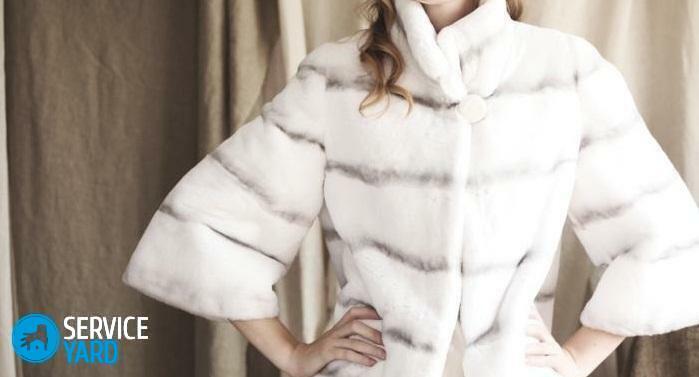During the repair, there is often a question about finishing the floors. Expensive coating materials such as cork, parquet or carpet are not always affordable. Tile very cold room and is suitable only for bathroom and toilet. Laminate is afraid of water and can deteriorate in inattentive operation. Unlike all the listed types, linoleum has a moderate cost, it retains heat, is moisture resistant and is designed for 25 years of service. A simple way of laying allows you to do all the work yourself and save on installation. But what are the types of linoleum and what are their key characteristics? Understanding these details will help to choose an excellent coverage for a particular room.
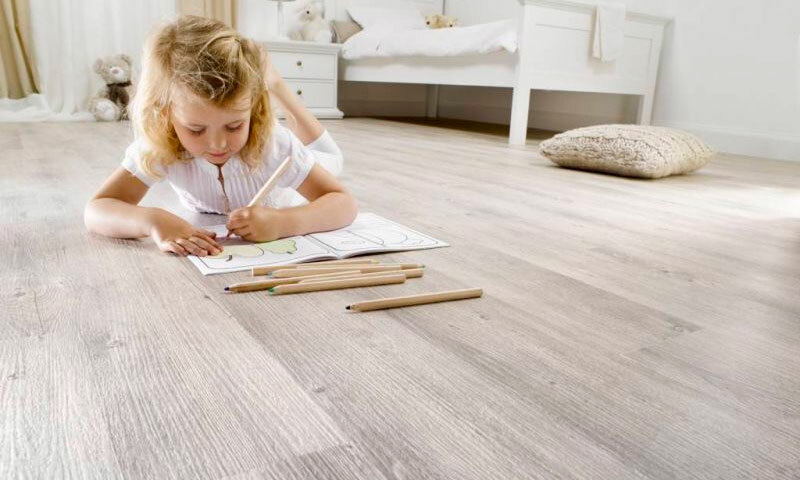
Contents:
- Best linoleum companies
- Structure and application of linoleum
- Linoleum types
- Linoleum selection parameters
- What linoleum to choose
- How much does linoleum cost
The best linoleum companies
Quality floor products are produced by both domestic and foreign factories. If there is no time to study the features and differences of linoleum and just want to quickly acquire excellent products for many years, then it is worth choosing among the products of these manufacturers:
- Armstrong;
- Grabo;
- Juteks;
- Tarkett;
- Forbo.
But if you want to understand not only the parameters of the material, but also get acquainted with specific models for different rooms, then you can read the detailed article of the best manufacturers of linoleum.
Structure and application of linoleum
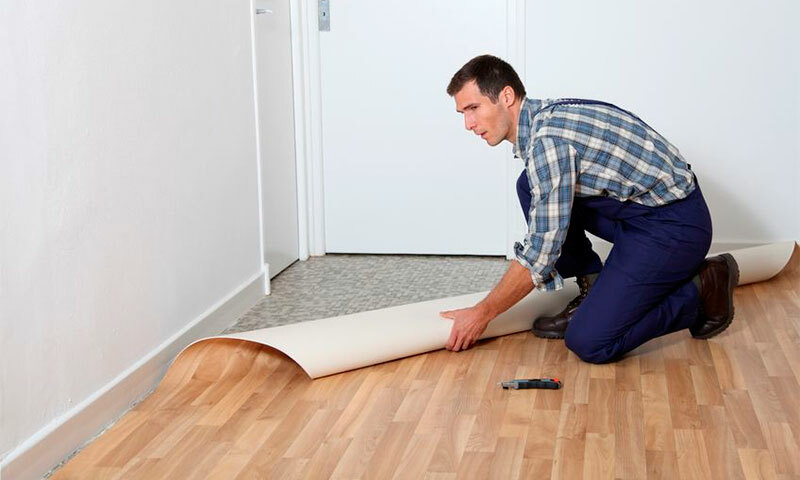
Linoleum is widely known for its versatility for use in various institutions and private housing. This is a relatively cheap material that does not crack with time, and its packing is quick and easy.
Linoleum can be of various origins depending on the substances used in its creation, but most models have a similar structure of six layers:
- Basis. Can be made from a textile or foam material. Responsible for the heat and sound insulation properties, as well as the flexibility of the canvas.
- Fiberglass. Adheres directly to the base and is responsible for the strength of the entire material. It can be reinforced or conventional.
- The basis of printing. To apply a beautiful and clear pattern, a layer is required that will absorb the paint well and prevent it from spreading.
- Surface stamping. Performed on the layer for printing and additionally gives expressiveness to the drawing.
- Protective layer. It can be made from various polymers and performs the main role in preventing abrasion of the pattern and the material itself.
- The last material that imparts gloss to the coating and serves as an additional protection is the PVC layer.
This multi-layer and not expensive material can have a different pattern and embossing, which makes it possible to reproduce on its surface a kind of natural wood. An inexperienced user can even confuse it with a parquet or laminate. The palette of shades facilitates the choice of material for any interior.
The floor covering can be:
- without foundation( in the form of several layers of basic substances) on which the applied pattern lasts for a long time;
- made of foam, which gives high moisture resistance and flexibility;
- from the fabric component, which ensures a long service life and high quality.
Distinctive feature of linoleum is its resistance to moisture. At the core of the product, there are no absorbent layers that are prone to swelling, and reliable protective coatings completely exclude this possibility. Thanks to such properties, it is an indispensable material for the kitchen, baths, corridors with a large patency and frequent wet cleaning. Linoleum is manufactured in a variety of thicknesses, which gives high levels of heat preservation and insulation from sounds. This allows you to put it in children's rooms and schools.
The popularity of linoleum is also attached to simple installation, which saves the money of the family. Rolls are rolled out and cut off with a stock in the size of the room. After giving them time to crack down a little, the floor is prepared: garbage is removed, cracks are filled up and the plinth is dismantled. After that, the styling and fixing is done. It can be an adhesive in the case of concrete floors or nails and strips for a wooden base( boards).The final stage is pruning of excess areas and fixing the plinth.
Versions of linoleum
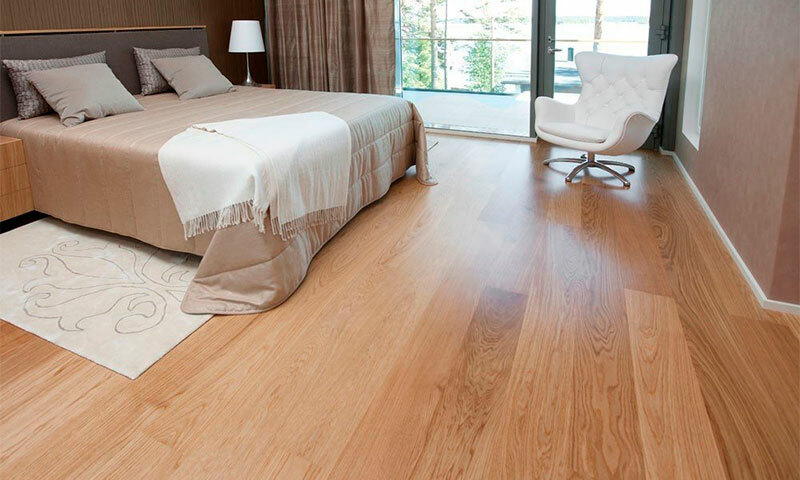
Manufacturers produce many types of linoleum differ not only in design and color, but also in the substances involved in its manufacture. This affects the application of the material and its cost.
Natural linoleum
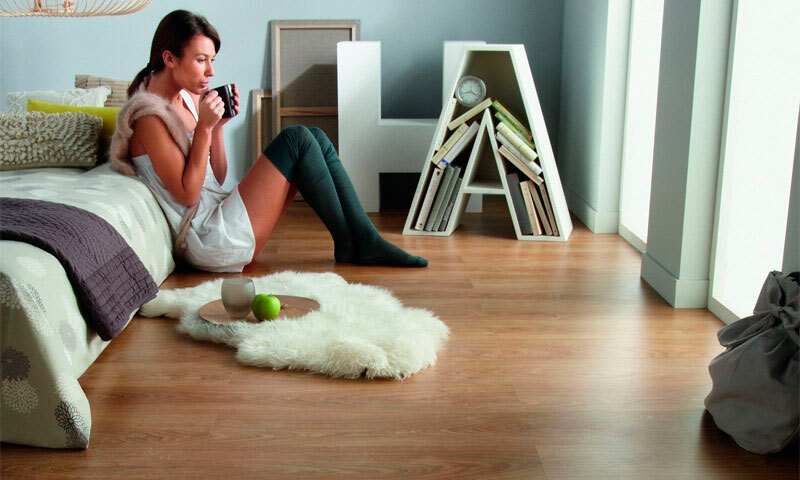
Excellent material from natural ingredients is good money. This is the kind of floor covering known as natural linoleum. Since the demand for it is not so great, it is more difficult to find such products on sale. This material will be an ideal solution for allergy sufferers and asthmatics, since natural substances will not irritate the mucous membranes and respiratory system.
We produce natural linoleum from jute fabric as a basis. The filling layers are wood and cork flour. Pine resin acts as a binding component, and it is dyed with limestone powder and natural pigment substances.
Pluses:
- is environmentally friendly;
- many colors;
- resistant outer layer;
- is easy to clean;
- does not deform from heat and ultraviolet;
- is not subject to burning( if you drop a burning match in the kitchen, there will not be a trace);
- prevents the formation of bacteria under it.
Disadvantages:
- expensive;
- in rooms with permanent spray is not advisable;
- can break when throwing in the warehouse;
- is brittle in bending, which requires very accurate installation.
PVC linoleum
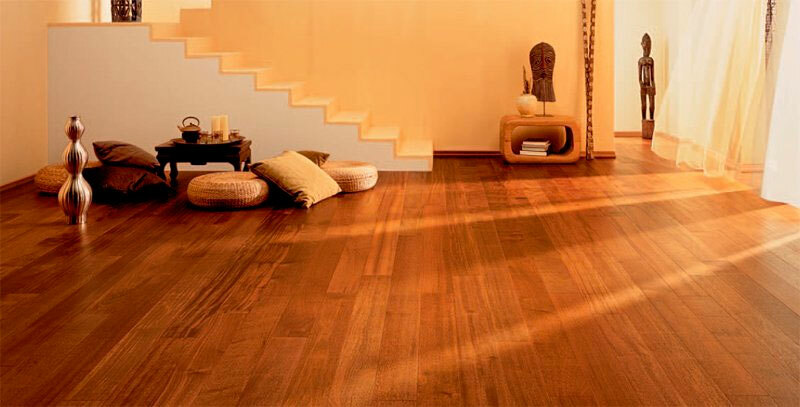
Refers to the most common types. Has a textile or foamed basis. Can be produced with a wide range of thickness. The outer layer of the polymer film protects the pattern and texture from abrasion. The material is distinguished by a large selection of colors and an affordable price. Suitable for children's and bedroom, office corridors, hospitals, schools and other institutions.
Advantages:
- does not transfer cold from concrete to the room;
- very simple laying technology;
- does not accumulate electricity and does not attract small debris;
- large selection of colors, patterns and sizes;
- is environmentally friendly;
- material does not rot in humid conditions and is designed for 15-20 years of operation;
- affordable price.
Disadvantages:
- can be deformed from high temperatures;
- , if chemicals remain, traces remain;
- on the cold floors loses its elasticity and cracks are possible;
- with time diverges at the joints due to the tightening of the internal structure.
PVC linoleum is called synthetic and is divided into three categories of use. The household segment of products is cheap, has a short service life( 5-10 years) and is not very thick. The semi-commercial options are used in public buildings with little traffic and are designed for 10-20 years. Often it is purchased and in apartments. Commercial products are distinguished by high cost and durability. A thick layer and additional protective coatings allow you to put it in offices and working rooms.
Additional linoleum types
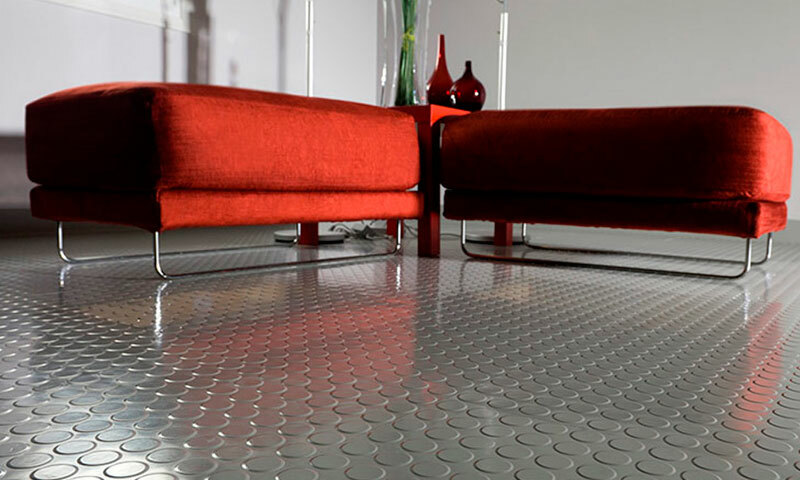
In addition to the main two types, there are additional types of linoleum with specific components, but it is much more difficult to find them on sale. One of them is the Relin. Rezinopodobny material is well suited for wet conditions( locker rooms gyms with showers, bathrooms, bathrooms).The product has two layers: hard from the bottom( bitumen) and smooth with a shade from above. Advantage is the water resistance and flexibility, and the disadvantage is the presence of volatile substances with an unpleasant odor.
Glyftal linoleum has a fabric base and a filler with colorants. Its alkaline component is alkyd resin. The product is characterized by a stable pattern and thermal insulation. Excellent smoothing of vibration. Of the shortcomings - quickly breaks on the bends, which complicates the styling. Great for a children's room.
The colloxylin product combines nitrocellulose and dye. It has no basis, therefore it is much thinner than analogues. It is resistant to water, surface gloss and flexibility, but with a change in temperature it tends to deform and shrink with time. Can be used only in private housing, for example, in the bedroom.
Linoleum selection parameters
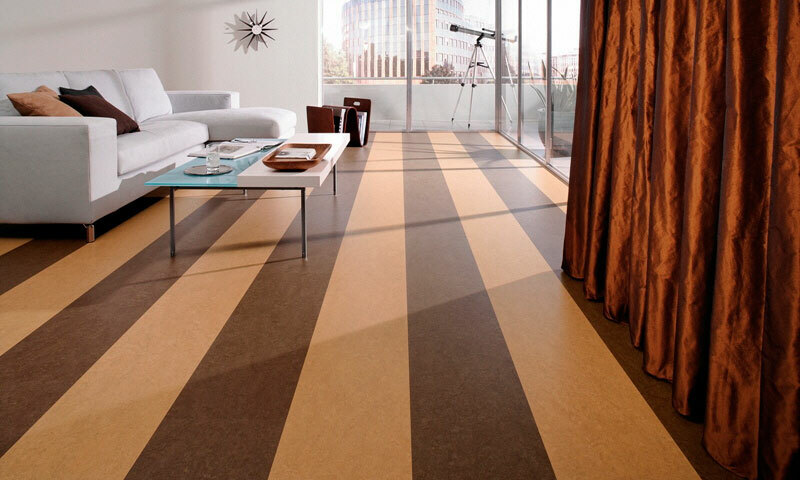
Despite the wide variety of materials used in the manufacture of linoleum, there are many parameters inherent in all types of this product. Understanding these features, you can quickly decide on the choice of flooring for specific conditions.
Used kind of the basis
The basic linoleum variants are thin enough that reduces their insulating properties. But the pattern penetrates the entire thickness of the product. Therefore, erasing the top layer will not lead to empty places in the part of the coating that is used to walk more. Therefore, such a product should be used in public places with low traffic( offices, offices).He will also suit for the hall in the apartment.
Foamed polyurethane gives a high layer and good heat retention. Moderate flexibility facilitates installation. This type of linoleum is suitable for most children's rooms, kitchens and bedrooms. The fabric base will allow the material to be used for a long time, which is applicable in schools and hospitals with high traffic. Also this kind is used in industrial shops and factories where there are no solid cutting items in circulation. The workers under their feet warm cover, which remains for a long time intact and beautiful.
Thickness of material
Linoleum can be of different thicknesses from 1.1 to 3.2 mm. This affects the insulation properties and comfort when walking barefoot. Therefore, in the children's room, where there will be a lot of noise and need a warm floor, the maximum thickness of 2.8-3.2 mm is suitable. The same index of thickness should be chosen in the case of high-traffic areas, and for the office there will be enough material layer in 1,2 - 1,6 mm.
Abrasion Resistance
This parameter indicates the life of the coating. The thicker the protective layer, the longer the integrity of the pattern and the color uniformity, regardless of the amount of material passing through the material, will last longer. The protective layer is indicated in mm and can vary from 0.15 to 0.8 mm. For a private house or apartment, the index is 0.2-0.3 mm( in the hallway and kitchen) and 0.15 mm for the bedroom, but in the educational institutions a value of 0.4-0.5 mm is needed.
Moisture resistance
This parameter is not prescribed separately, but the material characteristics are evident from the substances in its composition. For kitchens and baths, where there is the greatest humidity, all types of PVC linoleum, as well as a two-ply structure, are suitable. Tissue and bezobnovnye better to put in dry rooms( bedroom, offices).
Width of rolls
Regardless of the type of linoleum chosen, pay attention to the width of the roll corresponding to the parameters of the room. If the room has an area of 3 x 4 m, then it is worth looking for variants of rolls with a width of 3 or 4 m. This will allow to put a solid sheet. Otherwise, joints will be required, which may differ from time to time. Rolls are 2.5-4 meters, but the possible intermediate options depend on the specific type of product.
Classification and marking of
The product always indicates two values: the first digit - the destination for the rooms, and the second - the class of patency. Room index 1-2 is suitable for living rooms, and 3-4 figures are worth looking for styling in office and industrial buildings. The class of patency combines many factors and forms a single maximum index. For example, for a bedroom there are 21 class covers, but in the kitchen it is worth buying a 23 class. The highest value of this value can be 32.
Drawing and quality
Although the color and pattern options are chosen according to your taste and in accordance with the existing design in the room, it is worth paying attention to the quality of the flooring material. Do not buy rolls with the same article from different lots, this is fraught with mismatched shades. When inspecting a roll during purchase, it is necessary to unfold it and study it for air bubbles, pores and bumps. All this indicates a low-quality manufacturing process.
The color on the surface must be uniform without visible differences. Scuffs in a new roll - the index of a thin protective film. The figure on a quality linoleum has the same clarity and shape.
Additional selection criteria for
Although most linoleums have a specific odor, it should not be so sharp that it is impossible to stay in the room. It can be checked only by personally inspecting the goods, and not via the Internet. Another factor is the combustibility of the material. In case of fire, the inflamed floors can cut off the path to a single exit. Even during melting, toxic substances for breathing will be released, so it is worth buying products with class G1 or G2 in residential and public places. For low-traffic areas, a lower G4 class is also suitable.
Which linoleum to choose
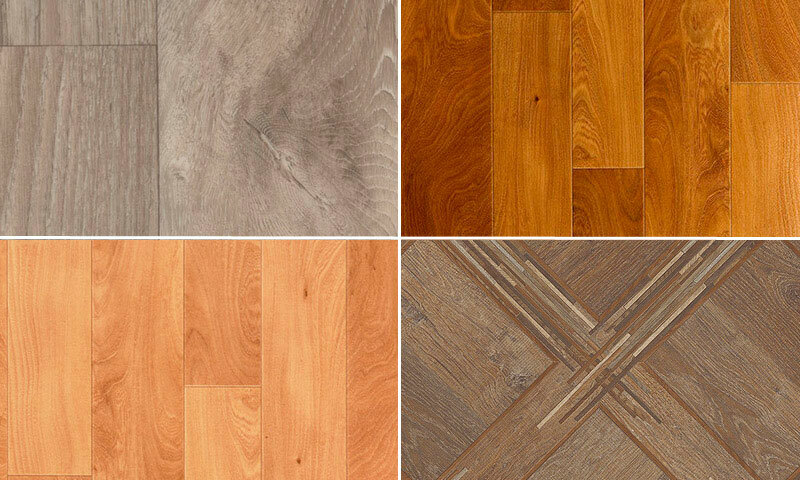
Having systematized most of the characteristics of this product, it is possible to single out the main indicators for the specific use of linoleum:
1. Classless material of 21 classes with 1 level of passability will fit into personal cabinets and living rooms.
2. For kitchens and bathrooms, PVC is required with the third level and the 24th class or a two-layer rhein.
3. Baby and bedrooms need a foamed base and a 3 mm layer. There will be enough 22 classes and 2 levels.
4. Schools and hospitals, as well as office corridors, should be equipped with fabric types of bases with 24 class and 4 level. The thickness will need 3.2 mm.
5. For allergy sufferers and children's camps with permanent residence only natural linoleum is suitable.
How much is the linoleum
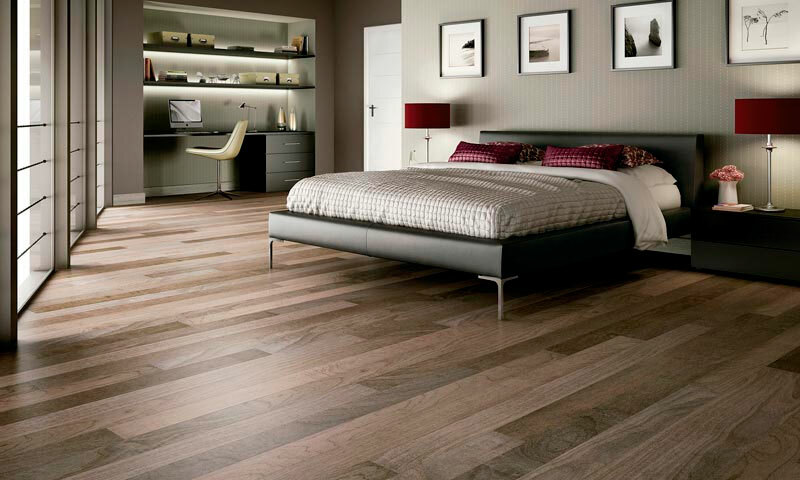
The price of this flooring depends on the substances used in the production and the parameters of thickness and wear resistance. For common types of rooms, linoleum will have the following price range:
- Natural material for asthmatics costs 1000-1900 rubles / m2.
- In the private office or hall coverage will cost 240-350 rubles per square meter.
- For the children's room and bedroom the price is 400-580 rubles / m2.
- In the bathroom and kitchen you will need to buy material for 450-600 rubles / m2.
- Premises with high traffic capacity require a wear-resistant coating, which has a price of 580-680 rubles / m2.


